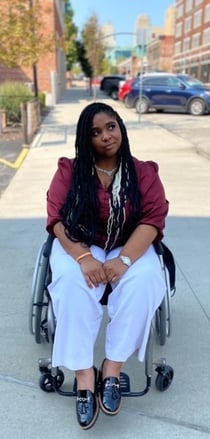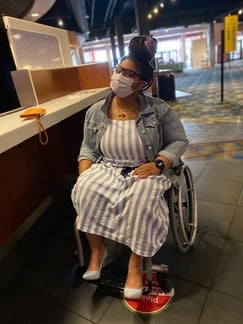Once, the idea of turning 30 filled Tyra Randle with dread.
It seemed so old, an age that marked an ending, rather than a beginning. But now, as that November day draws near, Randle is ready to celebrate.
“I’m just happy to be here,” she says.
In January 2020, Randle was shot eight times by her ex-partner. Lying on the bed, desperately hoping help would arrive soon, her mind could not process what had happened to her body—all she could think about were her children, two-month-old Karter and 11-year-old A’Niah. She prayed that she would not die and leave them alone.

A few days later, Randle woke up in an intensive care unit and realized she had survived—and that she was paralyzed.
“I had a lot of emotions,” she says. “I was crying. I was like, ‘How am I going to do this?’ But I also had to be grateful. I had asked God to save me. And I was still here, and able to be with my kids.”
Every day, Randle forced herself to focus on what she could control. Her biggest fears stemmed from an inability to imagine what life looked like with a T11-T12 injury. She couldn’t conjure the future, but as a longtime certified nursing assistant with experience in rehabilitation units, Randle knew the work she did in the present would matter dearly.
“I was very, very determined,” she says. “I knew the most progress happens in the first 12-18 months, so I would go hard, doing all three hours of my therapy. I wanted to show my kids, especially my daughter, that no matter what, I was going to fight to do the best I could for them.”
With each new milestone—brushing her teeth, bathing herself—Randle felt stronger. Allowing herself to accept help for the tasks she could not yet do took more time.
“I had always been the helper and the strong friend,” she says. “To sit there and be vulnerable and have people help me was kind of hard. I just kept telling myself, ‘Tyra, all these people helping you now is just showing how much you have helped other people, and how much they love you back.’”
 The support she received from family and friends carried Randle through the first few months, but even as she celebrated her progress, an ever-present undercurrent of anxiety was impossible to shake; could she really regain her life?
The support she received from family and friends carried Randle through the first few months, but even as she celebrated her progress, an ever-present undercurrent of anxiety was impossible to shake; could she really regain her life?
“The biggest challenge was when I left rehab,” she says. “I did not want to leave. I was terrified of getting out on my own in the real world, working and living and doing things. Really terrified.”
But Randle again thought about her children.
“They were constantly my main concern,” she says. “I knew I just had to get out there and be persistent and try not to be scared.”
She moved home but resisted the temptation to simply stay in her apartment. She took trips to Target and Walmart, using the wide aisles to practice moving through the world in her wheelchair. She visited the mall with Karter strapped across her lap and maneuvered through crowded school gymnasiums to watch A’Niah play volleyball.
And she returned to work, not as a nursing assistant but as a floating secretary at the hospital. As with every new effort after the injury, Randle was initially nervous. But as she began helping with the hospital’s COVID unit and serving as an extra set of hands for the nurses, she felt her old sense of self bubble up.

“When the nurses need something, I’m there,” she says. “I’m a little shorter and on wheels, but it’s ok. I roll around and I help, and I’m like “’I got this.’”
Some challenges over the past year and a half have been harder to conquer. Randle’s apartment was not accessible, so she could not easily shower or fit with the wheelchair in the bathroom where she used to bathe Karter—a loss that has pierced her. But, after a long and frustrating search, she recently found a home that will accommodate the shape of her new life.
“I’ll probably cry when I give him that first bath,” she laughs. “It’s going to be ok.”
Randle reminds herself to be patient; she has learned that the emotional recovery from both the spinal cord injury and the violence that caused it is complicated. She struggles with anger, with being stared at, with the frustrations of navigating a frequently inaccessible world. She practices devotionals and listens to sermons when she feels sad. Therapy twice a week helps, too.


 The support she received from family and friends carried Randle through the first few months, but even as she celebrated her progress, an ever-present undercurrent of anxiety was impossible to shake; could she really regain her life?
The support she received from family and friends carried Randle through the first few months, but even as she celebrated her progress, an ever-present undercurrent of anxiety was impossible to shake; could she really regain her life?